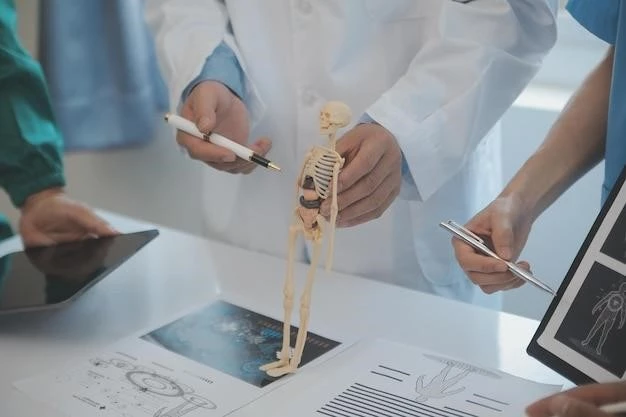Disease ⎼ Jansen Type Metaphyseal Chondrodysplasia
Overview of Jansen Type Metaphyseal Chondrodysplasia
Jansen Type Metaphyseal Chondrodysplasia is a rare disorder characterized by skeletal abnormalities affecting bone development. Individuals with this condition experience growth retardation, joint pain, and bowed legs. The genetic cause of Jansen type metaphyseal chondrodysplasia is a gene mutation in the PTH1R gene. This mutation leads to the overactivation of a receptor involved in bone metabolism٫ resulting in skeletal dysplasia.
Diagnosing Jansen type metaphyseal chondrodysplasia involves genetic testing to identify the specific gene mutation. Genetic counseling is essential for affected individuals and their families to understand the inheritance pattern of the condition. Orthopedic management plays a crucial role in addressing the skeletal abnormalities and managing symptoms. Medical treatment may include medications to alleviate pain and physical therapy to improve mobility and function.
Early intervention is key in the treatment of Jansen type metaphyseal chondrodysplasia to optimize outcomes and quality of life for affected individuals. Despite the challenges posed by this rare disorder, advances in medical care and orthopedic interventions offer hope for improved prognosis and long-term management of the condition.
Genetics and Gene Mutation
Jansen Type Metaphyseal Chondrodysplasia is caused by a gene mutation in the PTH1R gene. This gene provides instructions for making a receptor involved in bone development and metabolism. The mutation in the PTH1R gene leads to the overactivation of the receptor, disrupting normal bone growth and development.
The gene mutation responsible for Jansen type metaphyseal chondrodysplasia is typically inherited in an autosomal dominant pattern, meaning that a mutation in one copy of the gene is sufficient to cause the condition. In some cases, the mutation may occur spontaneously in individuals with no family history of the disorder.
Genetic testing is essential for confirming the diagnosis of Jansen type metaphyseal chondrodysplasia and identifying the specific gene mutation present in affected individuals. Understanding the genetic basis of the condition is crucial for genetic counseling, family planning, and potentially for the development of targeted therapies in the future.
Bone Development and Skeletal Abnormalities
In Jansen Type Metaphyseal Chondrodysplasia, bone development is affected due to the gene mutation in the PTH1R gene, leading to skeletal abnormalities. The overactivation of the receptor encoded by the mutated gene disrupts the normal process of bone growth and development.
Individuals with Jansen type metaphyseal chondrodysplasia may exhibit various skeletal abnormalities, including bowed legs, short stature, and other deformities in the long bones of the arms and legs. The metaphyses, the growing regions near the ends of bones, are particularly impacted, resulting in characteristic changes seen on imaging studies.
These skeletal abnormalities can cause functional limitations, joint pain, and difficulties with mobility. The unique pattern of bone dysplasia seen in Jansen type metaphyseal chondrodysplasia distinguishes it from other skeletal disorders and aids in the diagnosis of the condition. Management strategies focus on addressing these skeletal issues to improve quality of life for affected individuals.
Clinical Presentation
Individuals with Jansen Type Metaphyseal Chondrodysplasia often present with a range of clinical symptoms related to skeletal abnormalities and bone dysplasia. Common features of the condition include growth retardation, bowed legs, joint pain, and skeletal deformities.
Children with Jansen type metaphyseal chondrodysplasia may exhibit short stature and delayed growth compared to their peers. The characteristic bowing of the legs can impact mobility and lead to gait abnormalities. Joint pain, especially in the hips and knees, may be present due to the structural changes in the bones.
On physical examination, individuals may show specific skeletal deformities such as widened metaphyses and irregularities in the shape of long bones. Imaging studies, including X-rays and bone scans, can reveal the distinctive skeletal features associated with Jansen type metaphyseal chondrodysplasia, aiding in the diagnosis of the condition.
Diagnosis and Genetic Counseling
Diagnosing Jansen Type Metaphyseal Chondrodysplasia involves a combination of clinical evaluation, imaging studies, and genetic testing. Physical examination may reveal characteristic skeletal abnormalities, such as bowed legs and joint pain. X-rays and bone scans can help confirm the diagnosis by showing specific bone dysplasia patterns.
Genetic testing plays a crucial role in identifying the gene mutation in the PTH1R gene responsible for Jansen type metaphyseal chondrodysplasia. Results of genetic testing can not only confirm the diagnosis but also provide information about the inheritance pattern of the condition, aiding in genetic counseling for affected individuals and their families.
Genetic counseling is essential in Jansen type metaphyseal chondrodysplasia to help individuals understand the genetic basis of the disorder, discuss family planning options, and address any concerns related to the condition’s inheritance. Counseling sessions are tailored to the specific needs of each family and provide valuable support and information throughout the diagnostic and management process.
Orthopedic Management
Orthopedic management plays a key role in addressing the skeletal abnormalities and functional limitations associated with Jansen Type Metaphyseal Chondrodysplasia. Treatment strategies aim to improve mobility, reduce pain, and optimize bone development in affected individuals.
Orthopedic interventions may include the use of braces or orthotic devices to support proper bone alignment and prevent further deformities. Surgical procedures, such as osteotomy (bone reshaping) or joint replacements, may be considered in severe cases to improve function and quality of life.
Regular monitoring by orthopedic specialists is crucial to assess the progression of skeletal abnormalities and adjust treatment plans accordingly. Physical therapy and rehabilitation programs are often recommended to enhance muscle strength, joint flexibility, and overall mobility in individuals with Jansen type metaphyseal chondrodysplasia.
Medical Treatment and Physical Therapy
Medical treatment for Jansen Type Metaphyseal Chondrodysplasia focuses on managing symptoms such as joint pain and improving quality of life for affected individuals. Pain medications, anti-inflammatory drugs, and supplements may be prescribed to alleviate discomfort and address bone health.
Physical therapy plays a crucial role in the management of Jansen type metaphyseal chondrodysplasia by promoting mobility, strength, and flexibility. Customized exercise programs tailored to the individual’s needs can help enhance muscle tone, improve posture, and reduce the impact of skeletal abnormalities on daily activities.
Occupational therapy may also be beneficial in teaching adaptive techniques and strategies to optimize independence and functionality in daily tasks. A multidisciplinary approach involving medical professionals, physical therapists, and other allied healthcare providers is essential to ensure comprehensive care for individuals with Jansen type metaphyseal chondrodysplasia.
Prognosis and Long-Term Outcomes
The prognosis for individuals with Jansen Type Metaphyseal Chondrodysplasia varies depending on the severity of skeletal abnormalities and the management strategies employed. Early diagnosis and intervention play a critical role in optimizing long-term outcomes and quality of life for affected individuals.
While Jansen type metaphyseal chondrodysplasia is a lifelong condition that requires ongoing monitoring and care, advancements in medical treatment and orthopedic management have improved prognosis and outcomes for many individuals. With proper medical interventions, individuals can experience reduced pain, improved mobility, and enhanced function.
Long-term outcomes in individuals with Jansen type metaphyseal chondrodysplasia are influenced by factors such as the extent of skeletal deformities, the presence of joint complications, and the individual’s response to treatment. Regular follow-up visits with a multidisciplinary healthcare team are essential to monitor progress, address any new issues, and adjust treatment plans as needed.
Importance of Early Intervention
Early intervention is crucial in the management of Jansen Type Metaphyseal Chondrodysplasia to address skeletal abnormalities, promote healthy bone development, and improve overall quality of life for affected individuals. Timely diagnosis and treatment can help mitigate the impact of the condition on physical function and mobility;

Starting interventions such as orthopedic management, physical therapy, and medical treatment early in the course of Jansen type metaphyseal chondrodysplasia can lead to better outcomes and reduced long-term complications. Early identification of the gene mutation through genetic testing enables healthcare providers to tailor specific treatments and support services for affected individuals.
By implementing a proactive and comprehensive approach to care, including regular monitoring, therapeutic interventions, and ongoing support, healthcare teams can effectively manage symptoms, optimize bone health, and enhance the overall well-being of individuals with Jansen type metaphyseal chondrodysplasia.
Conclusion
In conclusion, Jansen Type Metaphyseal Chondrodysplasia is a rare genetic disorder characterized by skeletal abnormalities, bone dysplasia, and growth retardation. The gene mutation in the PTH1R gene plays a central role in the pathogenesis of the condition, leading to skeletal dysplasia and joint complications.
Early diagnosis, genetic counseling, and multidisciplinary care are essential for managing Jansen type metaphyseal chondrodysplasia effectively. Orthopedic interventions, medical treatments, and physical therapy can help alleviate symptoms, improve mobility, and optimize long-term outcomes for affected individuals.
By emphasizing the importance of early intervention, regular monitoring, and personalized care plans, healthcare providers can support individuals with Jansen type metaphyseal chondrodysplasia in overcoming challenges associated with the condition and enhancing their quality of life. Continued research and advancements in treatment hold promise for further improving the prognosis and management of this rare skeletal dysplasia.
